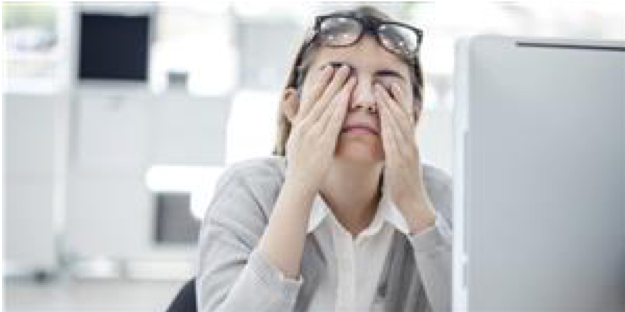Since Spring of 2020, we have increased screen time with our daily use of our electronic devices for our virtual work meetings and our virtual school classrooms.
As we head into Autumn of 2020, Eye Physicians & Surgeons want to remind you to protect your eyes from increased electronic screen time and share valuable information about blue light blocking glasses.
What is blue light?
Blue light and blue light blockers have been in the news recently. It is helpful to know what science tells us about blue light and its relationship to our eye health. Blue light has a short wavelength and is one of the colors visible to us, as part of the visual light spectrum. All light we see is a combination of these wavelengths, including light from the sun and computer screens.
Can blue light damage our eyes and cause irreversible damage?
Over the past few years, there have been studies about the benefits of blocking blue light from our electronic screens. Most of the studies have been in animals & in cells, not humans. The studies with humans were with people exposed to outdoor blue light. Eye glasses with special blue light-blocking filters claim to absorb the excess blue light from our electronic devices and:
- Help us sleep easier at night
- Reduce digital eye strain
- Prevent permanent eye disease, such as macular degeneration
Too much light exposure from our electronic screens in the evening may disrupt our natural sleep cycle. Light slows the production of melatonin—the sleep hormone—in our body. Blue light blocking glasses will not change your natural sleep cycle but for more restful sleep, it is important to reduce the amount of blue light before bedtime. As suggested by the American Academy of Ophthalmology:
- Set electronic devices to night or dark mode in the evening. This setting decreases screen brightness.
- Avoid using electronic screens 30 to 60 minutes before bedtime.
Blue light blocking glasses may help our symptoms of eye strain but will not prevent serious eye disease.
What is Eye Strain?
When we stare at our electronic devices, we can experience eye strain in different ways, including:
- headaches
- dry eyes
- blurry vision
- tearing or watery eyes
- fatigue
Eye strain develops, in part, because we use certain eye muscles for reading & they can become fatigued with prolonged work. Also, we blink less when we stare at our electronic devices & our eyes tend to become dry. According to the American Academy of Ophthalmology, humans normally blink about 15 times per minute. It is estimated that we blink about half as often because of increased staring at our screens.
So how do we improve the situation? The American Academy of Ophthalmology suggests:
- Take frequent breaks by using the “20-20-20” rule.
Every 20 minutes, look away from your screen & look at an object 20 feet away, for at least 20 seconds. Set a timer if that helps. This will help relax the eye muscles which you use during reading.
- Use artificial tears to lubricate your eye
- Keep your distance. Sit about 18 to 25 inches from your screen & adjust its height so your neck and back don’t hurt.
- Reduce glare & brightness. To reduce glare, position the light source behind the back, not behind the computer screen. Adjust the screen brightness & contrast, so that it is comfortable. Avoid using electronic device in a dark room, as the pupil size increases, the brightness of your screen can worsen after-images & cause discomfort.
Blog post by Jennifer A. Galvin, MD, a Board-Certified ophthalmologist with fellowship training in pediatric ophthalmology and strabismus at Eye Physicians & Surgeons PC.
Call Eye Physicians & Surgeons PC at (203) 878-1236 to make an appointment today: Your Vision is Our Focus. Visit our offices in Fairfield County and New Haven County. We have five offices: Westport, Shelton, Milford, Orange, Branford.
Credit for images: American Academy of Ophthalmology. www.aao.org



